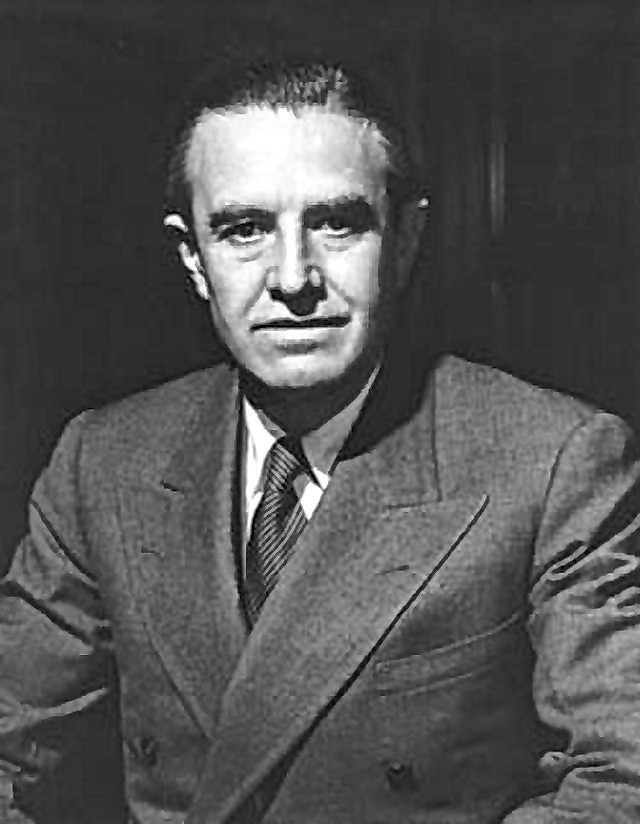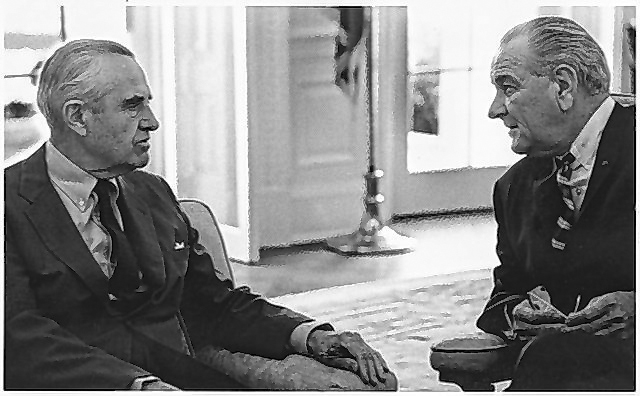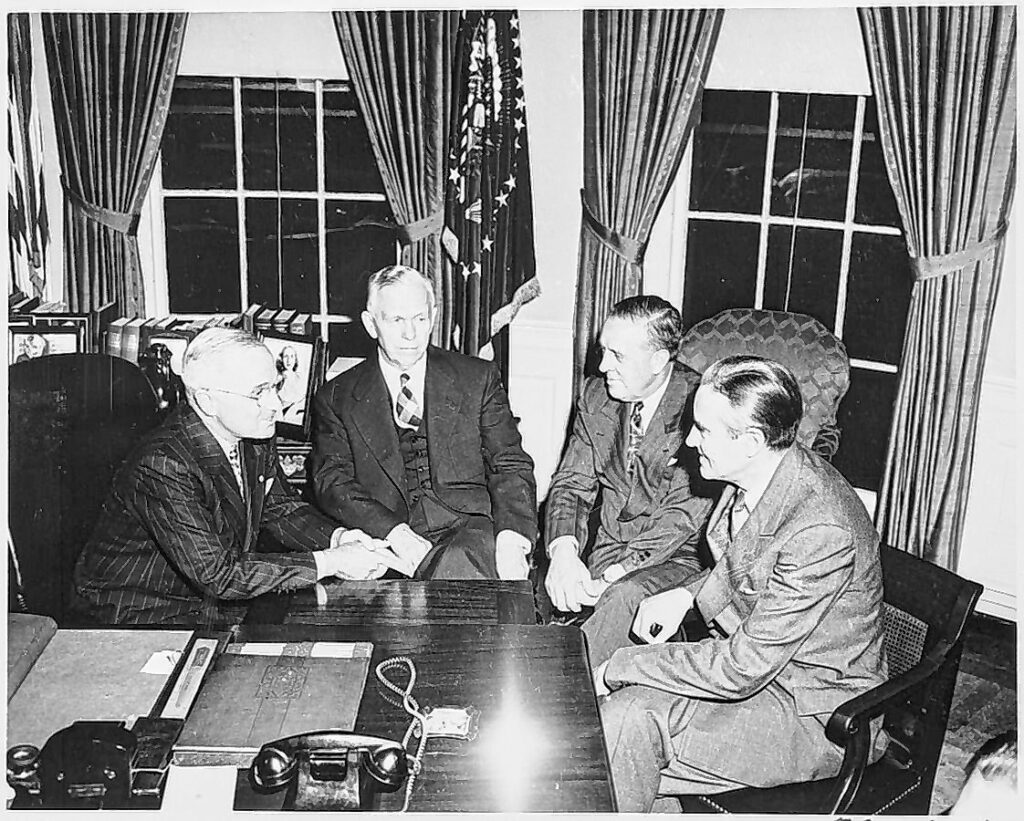
Being governor of New York is one of the most high-profile positions in American politics. There was a time when holding that job made one an instant potential candidate for president.
Longtime Port Washington resident Averell Harriman was both a governor of New York and in 1952 and 1956, a candidate for the Democratic Party’s presidential nomination.
Harriman may be forgotten, but he was a competent governor at a time of relative peace and prosperity in both New York and the United States. He was also a diplomat who helped to shape the post-World War II world that Americans were now destined to lead.
Harriman was old stock New York. His father was a railroad executive at a time when that mode of transportation dominated the American landscape. He was the fifth of six children born to E.H. and Mary Harriman. He attended the Groton School in Massachusetts and Yale University. Harriman was a successful investment banker, engaging in shipbuilding, shipping aviation and mining operations, eventually, at age 41, becoming chairman of the board of Union Pacific Railroad.
Harriman served in that post until 1946. By then, public service beckoned. With the election of his fellow New Yorker and childhood friend, Franklin D. Roosevelt in 1932, Harriman went to Washington, working for the National Recovery Administration (NRA).
That appointment began a second career, one of a bureaucrat and eventually, a globe-trotting diplomat. Harriman served as the U.S. Ambassador to both the Soviet Union and Great Britain.

(Wikimedia Commons)
Harriman was there “at the creation.” In 1940, the United States took a momentous step, shedding its centuries-old policy of armed neutrality in favor of a Lend Lease program of aid to an embattled Great Britain. Franklin Roosevelt and Winston Churchill also drew up their “four freedoms,” a guide to a liberal world order. Harriman was now a key advisor to Roosevelt and the former was named to sell the Atlantic Charter to his counterparts in the Soviet Union. Harriman also played a factor in securing American aid to Moscow. Critics argued that such aid came without preconditions, which Joseph Stalin would have rejected. Harriman argued that the first order of business was defeating Nazi Germany. Russia, communist or not, was a needed ally.
Harriman was with Roosevelt at both the Tehran and Yalta conferences. It was at Tehran that the initial appeasement of Russia concerning Poland and Eastern Europe took place. Harriman took a harder line than his boss. For his part, Roosevelt had made up his mind to run again in 1944. He wanted the Polish sellout concealed until after that election, lest he lose the key Polish-American vote in the upcoming contest.
When World War II ended, Harriman was one of the legendary “wise men” who served as architects of the postwar policy of containment against the Soviet Union and in general, the management of an America-led global order. With World War II, the European empires were in retreat. Statesmen such as Harriman, George Kennan, Dean Acheson, Charles E. Bohlen, Robert A. Lovett and John J. McCloy all guided the nation into uncharted waters.
Harriman took great interest in Kennan’s “Mr. X” article advising a containment policy towards the Soviet Union. He also helped to bring both China and France into the United Nations, rounding out the five nations (including the United States, the United Kingdom, and the Soviet Union) that made up that body’s National Security Council. Harriman was very much part of the Democratic Party’s dominant anti-communism wing.
At first, a new order seemed simple enough. After the war, the United States had unprecedented wealth and power. Over half of the world’s Gross National Product (GNP) was in the hands of the United States. But trouble lay ahead, and Harriman would be in the thick of it.
Harriman remained a hawk. He counseled firmness towards Moscow during the 1962 Cuban Missile Crisis, while also advising President John F. Kennedy to give the Soviets a face-saving exit, which Kennedy did by removing American nuclear missiles from Turkey.
Harriman’s generation was born to lead. It all fell apart in Vietnam. When civil war broke out in neighboring Laos, Harriman, now a roving ambassador for the Kennedy Administration, counseled neutrality for southeast Asia, believing that the region was not important to American interests. When the South Vietnamese government was under siege from Viet Cong guerillas, Harriman told North Vietnamese cabinet minister, Ung Van Khiem, that his country should stop supporting the Viet Cong. That, Harriman explained, was the road to real peace.
Harriman was tough on the South Vietnamese as well. According to biographers, he supported a 1963 coup against South Vietnam president Ngo Dinh Diem in 1963. Military men in the Kennedy Administration wanted Diem in power, mainly as source of stability.
Kennedy was indecisive, but also believed that Diem’s corruption made a communist takeover of the South inevitable. The United States was already knee-deep in the Big Muddy.
Harriman’s final diplomatic mission ended in failure. In early 1968, President Lyndon Johnson decided to not seek re-election. The president, however, wanted to end the Vietnam War before the fall elections. A loyal Democrat, Harriman held the same sentiments.
Harriman now opposed the hawks. He argued for a bombing halt of North Vietnam to get the talks moving. Progress was being made. However, South Vietnamese officials refused to hold peace talks if the National Liberation Front (the Viet Cong) was included. For decades, frustrated Democrats blamed Richard Nixon, the Republican Party’s presidential nominee and the man’s future Secretary of State, Henry Kissinger, for sabotaging the talks, with the latter allegedly leaking details to the GOP camp.
In retirement, Harriman opposed the war. He was a featured speaker at a massive Oct. 15, 1969 Moratorium to End the War in Vietnam rally in New York, where he warned that President Nixon would “have to pay attention” to the nationwide protests.
There was more to Harriman than diplomacy. The man caught the political bug. In 1952, the well-known but hardly famous Harriman ran for the Democrats’ presidential nomination. He ran again in 1956, this time with the support of former President Harry Truman.
By 1956, Harriman was now governor of New York. The 1952 campaign gave him a heightened public profile and he parlayed that into a successful 1954 statewide victory.
That win illustrated both the deep urban/rural divide in New York politics and the strength of the Democratic vote in New York City. Harriman won only five of the state’s 62 counties (Manhattan, the Bronx, Kings, Queens and Albany). That was enough. He defeated his Republican opponent, Irving Ives by only 11,000 votes.
New York prospered under Harriman’s tenure. What was New York in the mid-to-late 1950s? It was the nation’s most populous state. People were leaving the city for Nassau and Suffolk counties. They were not, however, leaving the state. New York was the Empire State. Florida remained a backwater.

The historian George Marlin described the landscape thusly:
“There were in reality three New Yorks. Greater New York was the leader in economic activity. Twenty-six percent of all employment was in manufacturing with printing, publishing and apparel clothing leading the way. The city’s arts and culture…made it the world’s communications hub.
“The rapidly growing suburban areas of Nassau, Rockland, Suffolk and Westchester counties…By 1960, thanks…to home loans by both the G.I. Bill and the F.H.A., the area skyrocketed 133 percent [in growth] to a population of nearly three million.
“The other 53 upstate counties with six million people…The whole of Upstate New York was as economically diverse as any region in the United States. It had heavy industry, manufacturing, high-tech, R & D, agriculture and dairy. There were glass factories, paper mills, electronic facilities, pottery kilns, textile mills, furniture makers, craftsmen making rugs and footwear.”
How did Harriman lose re-election? Did failed campaigns for the presidency in both 1952 and 1956 give him a negative image as a “loser?” Was he, in the eyes of some voters, more interested in being president than governor?
According to Marlin, the man had to deal with the fleet-footed Nelson Rockefeller. For upstate audiences, Rocky could orate in the language of conservatism. In the city, Rockefeller gave progressive speeches to a liberal audience. There were also the divisions within the Democratic Party. Tammany Hall boss Carmine DeSapio wielded great power. He was liberal, but his old-fashioned politics were opposed by progressive activists. Liberal Democrats were comfortable voting for the Republican Rockefeller. A new era in New York politics had begun.
A new era in Harriman’s life had begun as well. It was back to serving his country as a diplomat in a world where the United States carried a heavy burden.
Men of Harriman’s generation were expected to do just that. They made their Wall Street millions, but they had to give something back. Harriman was glad to serve wherever his country needed him. In retirement, the man received well-deserved honors: The Presidential Medal of Freedom, the Sylvanus Thayer Award from the United States Military Academy, and the Freedom Medal. Still, Vietnam, rather than his electoral defeats, remained Harriman’s greatest disappointment.


















